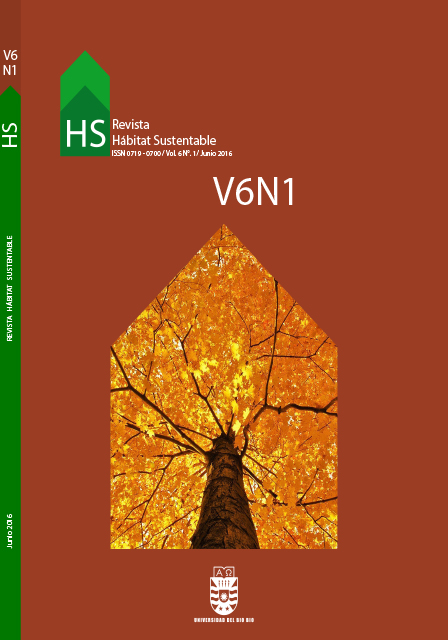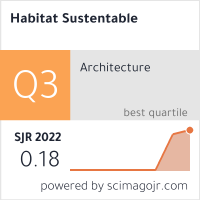Pautas de diseño para disminuir las temperaturas urbanas en regiones con alta productividad solar. Parámetros morfológicos y materiales
Palabras clave:
diseño urbano, diseño urbano, fachadas, morfología, materiales, morfologíaResumen
El estudio aquí expuesto examinó el potencial de las características del perfil urbano -morfología y materialidad- para disminuir las temperaturas urbanas. El objetivo consistió en identificar pautas de diseño y rehabilitación urbana, que permitan densificar áreas residenciales de la ciudad de Mendoza, Argentina. Para ello fueron simulados 32 escenarios con el programa ENVI-met 3.1, en los cuales se combinó distintos niveles de reflectancia solar (albedo) de los materiales que conforman las envolventes, diversas morfologías de perfil urbano, y presencia y ausencia de forestación dentro del canal vial, variando su orientación E-O y N-S. A partir de los resultados obtenidos por las simulaciones, se infiere que aquellos canales viales que presentan un comportamiento térmico más eficiente, están vegetados, y, morfológicamente, su perfil urbano es continuo sobre la línea municipal. En cuanto a la materialidad de sus envolventes, presentan niveles de albedo altos (0.7) en techos y pavimentos, y niveles de albedo bajo (0.3) en fachadas.
Descargas
Citas
AKBARI, Hashem; LEVINSON, Ronnen y STERNB, Stephanie. Procedure for measuring the solar re ectance of at or curved roo ng assemblies. Solar Energy, 2008, vol. 82, n°7, pp. 648-655.
AKBARI, Hashem; MENON, Surabi y ROSENFELD, Arthur. Global cooling: increasing world-wide urban albedos to offset CO2. Climatic Change, 2009, vol. 94, n°3, pp. 275-286.
ALCHAPAR, Noelia; CORREA, Érica y CANTÓN, M. Alicia. Classi cation of building materials used in the urban envelopes according to their capacity for mitigation of the urban heat island in semiarid zones. Energy and Buildings, 2014, n°69, pp. 22-32.
ALCHAPAR, Noelia y CORREA, Érica. Aging of roof coatings. solar re ectance stability according to their morphological characteristics. Construction and Building Materials, 2015, n°102, pp. 297-305.
ALI-TOUDERT, Fazia y MAYER, Helmut. Numerical study on the effects of aspect ratio and orientation on an urban street canyon on outdoor thermal comfort in hot and dry climate. Building and Environmet, 2006, n°41, pp. 94-108.
BRUSE, Michael. ENVI-met 3.1. On-Line Manual [en línea], 2006. [Consultado 22 mayo 2016] Disponible en: http://www.envi-met. com.
CORREA, Érica. Isla de Calor Urbana. El caso del área metropolitana de Mendoza. Tesis doctoral inédita, Universidad Nacional de Salta, Argentina, 2006.
CORREA, Érica; RUIZ, M. Angélica y CANTÓN M. Alicia. Morfología forestal y confort térmico en “ciudades oasis” de zonas áridas. Ambiente Construido, 2010, vol. 10, n°4, pp. 119 -137.
DOYA, Maxime; BOZONNET, Emmanuel y ALLARD Francis. Experimental measurement of cool facades performance in a dense urban environment. Energy and Buildings, 2012, n° 55, pp. 42-50.
ERELL, Evyatar; PEARLMUTTER, David; BONEH, Daniel y KUTIEL, Pua Bar. Effect of high-albedo materials on pedestrian heat stress in urban canyons. Urban Climate, 2014, n°10, pp. 367-386.
GIVONI, Baruch; Noguchi, MIKIKO; SAARONI, Hadas; POCHTER, Oded; YAACOV, Yaron; FELLER, Noa y BECKER, Stefan. Outdoor comfort research issues. Energy and Buildings, 2003, vol. 35, n°1, pp. 77-86.
JOHANSSON, Erik y EMMANUEL, Rohinton. The in uence of urban design on outdoor thermal comfort in the hot, humid city of Colombo, Sri Lanka. International Journal Biometeorology, 2006, vol. 51, n°2, pp. 119-133.
KOTTEK, Markus; GRIESER, Jürgen; BECK, Christoph; RUDOLF, Bruno y RUBEL, Franz. World Map of the Köppen-Geiger climate classi cation updated. Meteorologische Zeitschrift, 2006, vol. 15, n° 3, pp. 259-263.
PEARLMUTTER, David; BERLINER, P., y SHAVIV, E. Urban climatology in arid regions: current research in the Negev desert. International Journal of Climatology, 2007, vol. 27, n°14, pp.1875- 1885.
SANTAMOURIS, Matheos. Advances in passive cooling (Buildings, energy and solar technology series). Londres: Earthscan Publications Ltd., 2007.
SANTAMOURIS, Matheos. Energy and climate in the urban built environment. New York: Routledge Publications. Taylor & Francis Group, 2011.
SANTAMOURIS Matheos. Cooling the cities - A review of re ective and green roof mitigation technologies to ght heat island and improve comfort in urban environments. Solar Energy, 2014, n°103, pp. 682-703.
SHASHUA-BAR, Limor; TSIROS, Ioannis y HOFFMAN, Milo. Passive cooling design options to ameliorate thermal comfort in urban streets of a Mediterranean climate (Athens) under hot summer conditions. Building and Environment, 2012, n°57, pp.110-119.
SHISHEGAR, Nastaran. The Impact of Green Areas on Mitigating Urban Heat Island Effect: A Review. The International Journal of Environmental Sustainability, 2014, vol. 9, n°1, pp. 119-130.
THORSSON, So a; LINDBERG, Fredrik; BJÖRKLUND, Jesper; HOLMER, Björn yRAYNER, David. Potential changes in outdoor thermal comfort conditions in Gothenburg, Sweden due to climate change: the in uence of urban geometry. International Journal of Climatology, 2010, vol. 31, n°2, pp. 324-335.
YAGHOOBIAN, Neda y KLEISSL, Jan. Effect of re ective pavements on building energy use. Urban Climate, 2012, vol. 2, pp. 25-42.
Descargas
Publicado
Cómo citar
Número
Sección
Licencia
El contenido de los artículos que se publican en cada número de Hábitat Sustentable, es responsabilidad exclusiva de los autores y no representan necesariamente el pensamiento ni comprometen la opinión de la Universidad del Bío-Bío.
Los autores/as conservarán sus derechos de autor y garantizarán a la revista el derecho de primera publicación de su obra, el cuál estará simultáneamente sujeto a la Licencia de Reconocimiento de Creative Commons CC BY-SA que permite a otros compartir-copiar, transformar o crear nuevo material a partir de esta obra con fines no comerciales, siempre y cuando se reconozcan la autoría y la primera publicación en esta revista, y sus nuevas creaciones estén bajo una licencia con los mismos términos.










 Programa de Información Científica/Concurso Fondos de Publicación de Revistas Científicas 2018/ Proyecto Mejoramiento de Visibilidad de Revistas UBB (Código:FP180007)
Programa de Información Científica/Concurso Fondos de Publicación de Revistas Científicas 2018/ Proyecto Mejoramiento de Visibilidad de Revistas UBB (Código:FP180007) 





